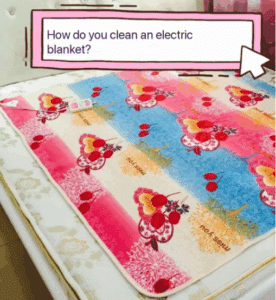Table of Contents
ToggleHow to wash a heated blanket is a crucial question for owners, as improper cleaning can damage the blanket and create safety hazards. Unlike regular bedding, heated blankets have internal electrical components requiring special care. Generally, a heated blanket consists of two layers: a fabric side and a fleece or woolen side. The heating wires are stitched between these layers and fixed onto the fabric side. Because of this construction, heated blankets are not suitable for conventional machine washing or soaking.
If the blanket surface becomes heavily soiled, use the following methods:
1. Cleaning Dust (Light Soiling)
If the blanket isn’t heavily soiled and just needs dust and bacteria removal:
-
Unplug & Vacuum: Ensure the blanket is completely unplugged. Use a vacuum cleaner with an upholstery attachment to thoroughly remove loose dust and debris.
-
Steam Refresh: Use a handheld garment steamer or a steam function on your iron (holding it slightly above the fabric). Gently steam the entire surface, working row by row. Never place a hot iron directly onto the blanket. The steam helps sanitize and refresh the fabric.
-
Air Dry: After steaming, hang the blanket or lay it flat to air dry completely in a shaded, well-ventilated area. Never expose a heated blanket to direct sunlight or high heat for drying.
2. Washing a Heavily Soiled Heated Blanket (Hand Wash ONLY)
How to wash a heated blanket when it’s very dirty requires extreme caution and is only recommended as a last resort. Water washing can compromise electrical safety and performance.
-
Protect Electrical Components: Securely wrap the plug, power cord, and control unit (if detachable) in a waterproof plastic bag and seal tightly. Ensure no water can reach these parts.
-
Prepare Wash Solution: Fill a bathtub or large basin with lukewarm water. Add a small amount of mild, neutral-pH detergent (specifically formulated for delicates or wool is ideal). Avoid bleach, harsh chemicals, or alkaline detergents as they can damage the heating wire insulation.
-
Partial Immersion: Submerge only the soiled fabric area of the blanket in the water. Crucially, keep the control unit, plug, and cord completely dry and outside the water. Avoid splashing.
-
Gentle Agitation:
-
Fabric Side: Gently agitate the water. Use a very soft brush (like a clean nail brush or soft-bristled clothes brush) to lightly scrub the fabric side only along the direction of the heating wires. Avoid scrubbing across wires or pressing too hard. Focus on heavily soiled spots.
-
Fleece/Wool Side: Use only your hands to very gently swish and press the fleece or wool side in the water. Avoid any vigorous scrubbing, twisting, or rubbing on this side, especially near the wires. Never use a brush here.
-
-
Rinse Thoroughly: Drain the soapy water. Refill the tub with clean, lukewarm water. Gently press and swish the blanket to rinse out all detergent. Repeat rinsing until the water runs clear. Never hold the blanket under running water forcefully.
-
Remove Water – NO WRINGING OR SPINNING! This is critical. Never wring, twist, or put a heated blanket in a washing machine spin cycle. Lay the blanket flat on a clean, waterproof surface (like a bathtub or large table covered with towels). Starting from one end, gently roll the blanket to press out as much water as possible. Unroll, smooth it out completely, and gently press other sections. Carefully lift and reposition it onto dry towels. Roll again with the towels to absorb more moisture. Repeat with dry towels until no more water is easily extracted. Ensure all folds and creases are smoothed out to maintain the blanket’s original shape.
-
Final Air Drying: Lay the blanket completely flat on a large drying rack or multiple clotheslines (supporting its full weight) in a shaded, well-ventilated area. Ensure it’s not folded or creased. Reshape it periodically as it dries. Drying can take 24-48 hours or longer. Never use a clothes dryer, radiator, heater, or direct sunlight.
-
Critical Safety Check Before Reuse: Once completely dry, plug in the blanket and let it run on a low setting for 5-10 minutes in a safe area (away from flammable materials). Use a voltage tester (non-contact tester is ideal) to carefully check along the entire length of the wires, especially near seams, folds, and the controller connection point. If the tester lights up anywhere other than the control unit/cord, DO NOT USE THE BLANKET. It indicates damaged insulation and a risk of electric shock. If it passes, unplug it and let it cool before storage or use.
Important: Washing a heated blanket significantly risks damaging its electrical components and insulation. The best way to avoid needing to wash your heated blanket is to always use a thin mattress pad, flat sheet, or regular blanket between you and the heated blanket. Never lie directly on it.
3. Storing Your Heated Blanket (When Not in Use)
When warmer weather arrives:
-
Clean & Dry: Ensure the blanket is completely clean (dust-free or washed/dried as above) and 100% dry before storage. Any moisture can lead to mildew and corrosion.
-
Cool, Dry, Dark Place: Store in a cool, dry, dark place like a closet shelf or under-bed storage box. Avoid attics (too hot), basements (too damp), or places near radiators, heaters, or direct heat sources, as heat accelerates insulation aging.
-
Roll or Loose Fold: Roll the blanket loosely or fold it gently to minimize creases. Avoid tight folds or sharp creases (“dead folds”) which can stress the wires. Place it on top of other items in storage, not under heavy objects. Long-term heavy weight can crush wires and insulation.
-
Protect from Punctures: Store away from sharp objects, pins, or pet claws. Never store with latex mattresses/toppers as the chemicals can interact. Never place sharp items on top.
-
Avoid Mothballs/Camphor: Do not store with mothballs or camphor balls. The chemicals can accelerate the aging of plastic components in the control unit and wire insulation. Use silica gel packets (desiccants) instead to absorb moisture.
4. Essential Heated Blanket Safety Precautions
-
Annual Check: Before each winter season, inspect the blanket carefully for any signs of wear, fraying, scorch marks, or damage to the cord/plug. Plug it in on a low setting for a few minutes on a non-flammable surface and use a voltage tester to check for leakage current (as described in Step 2.8). If any damage is found or the tester indicates a problem, discard the blanket immediately.
-
Right Side Up: Always place the blanket with the fabric side (where wires are attached) facing DOWN towards the mattress. Placing it fleece-side down can trap heat and damage wires.
-
Lay Flat, Never Folded in Use: Always spread the blanket completely flat on the bed. Never tuck it in tightly, fold it, or use it while bunched up. This can cause overheating and damage wires.
-
Pre-heat & Unplug: Turn the blanket on 30-60 minutes before bedtime to warm the bed. ALWAYS unplug the blanket before getting into bed. Unplug it when not in use.
-
Prevent Physical Damage: Keep children from jumping on the bed while the blanket is in use or stored. NEVER stick pins or sharp objects into the blanket. Never use scissors near it. Avoid sitting on it for prolonged periods in one spot if possible.
-
Buy Certified: Only purchase heated blankets with recognized safety certifications (like UL, ETL, CE) from reputable brands. Check for a valid inspection certificate. Cheap, uncertified blankets pose significant fire and shock risks.
By following this guide on how to wash a heated blanket safely and adhering to the usage and storage precautions, you can extend the life of your blanket while prioritizing safety. Remember, prevention (using a top sheet) is always better than washing!
Cleaning Advantages of Graphene Heating Blankets
Material Properties
-
Water Resistance: Graphene inherently possesses stable physicochemical properties. Premium products utilize fully sealed waterproof technology (e.g., TPU lamination encapsulation), allowing direct surface wiping with a damp cloth.
-
Antibacterial Performance: Graphene naturally inhibits bacterial growth, reducing odor buildup and minimizing the need for deep cleaning.
-
Simplified Structure: Some models replace internal metal wires with carbon nano-film heating elements, eliminating issues like oxidation and fragility common in traditional heating wires.
Cleaning Flexibility
-
Spot Cleaning Capability: Most blankets permit direct wiping of soiled areas with a damp cloth + neutral detergent, eliminating full immersion.
-
Partial Machine-Wash Support: Select brands (including our electric blanket factory) offer machine-washable models. Always verify the label states “Machine Washable” and follow specified settings (e.g., gentle cold-water cycle).

